
The 42nd International 500-Mile Sweepstakes was held at the Indianapolis Motor Speedway on Friday, May 30, 1958. The event was part of the 1958 USAC National Championship Trail, and was also race 4 of 11 in the 1958 World Championship of Drivers.

The 43rd International 500-Mile Sweepstakes was held at the Indianapolis Motor Speedway on Saturday, May 30, 1959. The event was part of the 1959 USAC National Championship Trail and was also race 2 of 9 in the 1959 World Championship of Drivers.
This article discusses the year-by-year history of the Indianapolis 500 race.

The 29th International 500-Mile Sweepstakes Race was held at the Indianapolis Motor Speedway on Friday, May 30, 1941. The start of the race was delayed due to a fire that swept through the garage area on race morning. No persons were injured, but one car in the field was destroyed. The race rolled off with only 31 cars, and ran to its scheduled distance. This would be the final "500" prior to the United States involvement in World War II along with the final race under with Eddie Rickenbacker as president of the speedway. He kept the track locked during the war before selling the track in November 1945 to Tony Hulman. The race returned a year later.
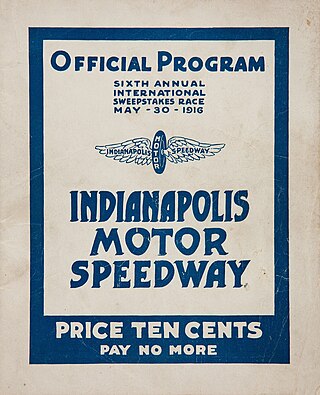
The 6th International 300-Mile Sweepstakes Race was the sixth running of the Indianapolis 500. It was held at the Indianapolis Motor Speedway on Tuesday, May 30, 1916. The management scheduled the race for 120 laps, 300 miles (480 km), the only Indianapolis 500 scheduled for less than 500 miles (800 km).

The 7th Liberty 500-Mile Sweepstakes was held at the Indianapolis Motor Speedway on Saturday, May 31, 1919.
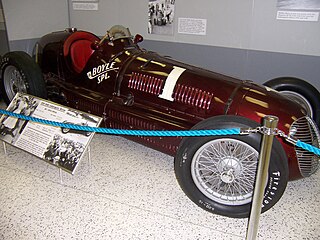
The 27th International 500-Mile Sweepstakes Race was held at the Indianapolis Motor Speedway on May 30, 1939. The race was won by the number two car of Wilbur Shaw, who started in the third position, driving a Maserati 8CTF. The race was notable for a three car accident on lap 109, when Floyd Roberts, the reigning champion, was killed when his car went through the wooden outer wall at over 100 miles (160 km) an hour at the backstretch. In Louis Meyer's final Indy 500, he too would crash at the backstretch at over 100 miles (160 km) an hour, but he walked away unharmed.
The 26th International 500-Mile Sweepstakes Race was held at the Indianapolis Motor Speedway on Monday, May 30, 1938. For 1938, riding mechanics were made optional; however, no teams utilized them in the race. In addition, after seven years, the engine specifications were changed again. The 1930 "Junk" formula was eliminated. Normally aspirated engines were allowed 4.5 liters, and superchargers would be permitted again, with a maximum displacement of 3.0 liters. Any fuel was allowed, which directly affected the race.
The 25th International 500-Mile Sweepstakes was held at the Indianapolis Motor Speedway on Monday, May 31, 1937. With temperatures topping out at 92 °F (33 °C), it is one of the hottest days on record for the Indy 500.
The 23rd International 500-Mile Sweepstakes Race was held at the Indianapolis Motor Speedway on Thursday, May 30, 1935. Despite attempts to improve participant safety by requiring crash helmets and installing green and yellow lights around the track, the event that year would prove to be one of the worst in terms of fatalities.
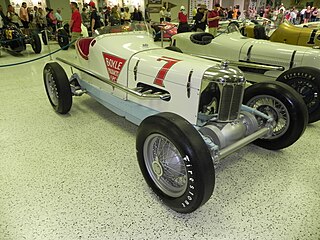
The 22nd International 500-Mile Sweepstakes Race was held at the Indianapolis Motor Speedway on May 30, 1934. The winner was the number seven car driven by Bill Cummings, an Indianapolis native, at an average speed of 104.863 miles per hour. Cummings led for 57 laps total, including the last 26. Of the 33 cars that began the race, only 12 were running at the finish, although there were no crashes resulting in serious injuries. One serious incident involved George Bailey, whose car went over the outside wall, but resulted in only a broken wrist to the driver. The finish was the closest in the history of the race to that point, with second-place finisher Mauri Rose within 100 yards of Cummings at the finish. Rose would also file a protest that Cummings had illegally gained ground during a "slow-down" period following a crash.
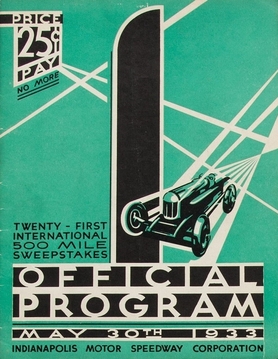
The 21st International 500-Mile Sweepstakes Race was held at the Indianapolis Motor Speedway on Tuesday, May 30, 1933. Louis Meyer defeated Wilbur Shaw by a time of 401.89 seconds. The average speed of the race was 104.162 miles per hour (167.632 km/h) while Bill Cummings achieved the pole position with a speed of 118.521 miles per hour (190.741 km/h). The race was part of the 1933 AAA Championship Car season.
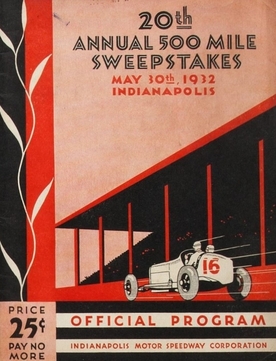
The 20th International 500-Mile Sweepstakes Race was held at the Indianapolis Motor Speedway on Monday, May 30, 1932. Attrition was the story of the race, with 26 of the 40 cars dropping out due to crashes or mechanical failure. A record eight different drivers led laps during the race, with no driver seemingly able to hold the lead without experiencing some sort of trouble. For the third year in a row, Billy Arnold looked as if he would be the dominant car, but he sailed over the turn three wall on lap 59. Rookie Bob Carey also hit the wall while leading. Fred Frame took the lead for good on lap 152, and won from the 27th starting position - the furthest back of any winner except for Ray Harroun in 1911 and later, Louis Meyer in 1936. Frame was accompanied by riding mechanic Jerry Houck.

The 19th International 500-Mile Sweepstakes Race was held at the Indianapolis Motor Speedway on Saturday, May 30, 1931. Race winner Louis Schneider, who led the final 34 laps, was accompanied by riding mechanic Jigger Johnson.

The 18th International 500-Mile Sweepstakes Race was held at the Indianapolis Motor Speedway on Friday, May 30, 1930. The race was part of the 1930 AAA Championship Car season.

The 14th International 500-Mile Sweepstakes Race was held at the Indianapolis Motor Speedway on Monday, May 31, 1926. Louis Chevrolet drove the Chrysler pace car for the start.
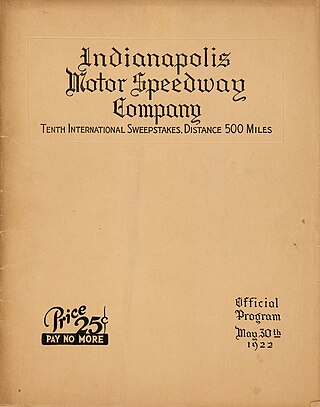
The 10th International 500-Mile Sweepstakes Race was held at the Indianapolis Motor Speedway on Tuesday, May 30, 1922.

The 9th International 500-Mile Sweepstakes Race was held at the Indianapolis Motor Speedway on Monday, May 30, 1921.

The 8th International 500-Mile Sweepstakes Race was held at the Indianapolis Motor Speedway on Monday, May 31, 1920.

The 4th International 500-Mile Sweepstakes Race was held at the Indianapolis Motor Speedway on Saturday, May 30, 1914.















